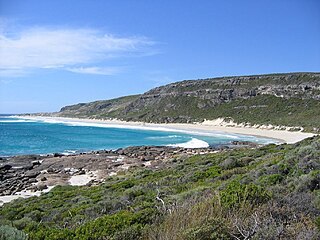Protected areas of Tasmania consist of protected areas located within Tasmania and its immediate onshore waters, including Macquarie Island. It includes areas of crown land managed by Tasmanian Government agencies as well as private reserves. As of 2016, 52% of Tasmania's land area has some form of reservation classification, the majority is managed by the Tasmania Parks & Wildlife Service. Marine protected areas cover about 7.9% of state waters.

Mole Creek Karst is a national park situated in the North of Tasmania, Australia, 168 km northwest of Hobart. It is located on the slopes of the Great Western Tiers to the east of the town of Mole Creek. It is the only national park in Tasmania created specifically to protect karst landforms. It is part of the Tasmanian Wilderness World Heritage Site.

Leeuwin-Naturaliste National Park is a national park in the South West region of Western Australia, 267 km (166 mi) south of Perth. It is named after the two locations at either end of the park which have lighthouses, Cape Leeuwin and Cape Naturaliste. It is located in the Augusta-Margaret River and Busselton council areas, and is claimed to have the highest visiting numbers of any national park in Western Australia. The park received 2.33 million visitors through 2008–2009.

The Marble Arch Caves are a series of natural limestone caves located near the village of Florencecourt in County Fermanagh, Northern Ireland. The caves are named after the nearby Marble Arch, a natural limestone arch at the upstream end of Cladagh Glen under which the Cladagh River flows. The caves are formed from three rivers draining off the northern slopes of Cuilcagh mountain, which combine underground to form the Cladagh. On the surface, the river emerges from the largest karst resurgence in Ireland, and one of the largest in the United Kingdom. At 11.5 kilometres (7.1 mi) the Marble Arch Caves form the longest known cave system in Northern Ireland, and the karst is considered to be among the finest in the British Isles.
Eucrenonaspides oinotheke is a species of crustacean in the family Psammaspidae, endemic to Tasmania, the only species described in the genus Eucrenonaspides. The Eucrenonaspides is a variation of the Anaspidaceans. It was described from a spring at 9 Payton Place, Devonport, Tasmania in 1980, making it "the first spring-dwelling syncarid recorded from the Australian region". It is listed as a vulnerable species on the IUCN Red List. A further undescribed species is known from south-western Tasmania.

The Ida Bay Railway is a 7-kilometre (4.3 mi), 2 ft narrow gauge heritage railway. Located 105 kilometres (65 mi) south of Hobart, Tasmania, it is the most southerly railway in Australia.

Sistema Huautla is a cave system in the Sierra Mazateca mountains of the southern Mexican state of Oaxaca. As of April 2021 it is the deepest cave system in the Western Hemisphere, 1,560 metres (5,120 ft) from top to bottom, with over 55 miles of mapped passageways. It is the tenth deepest cave in the world. It is also the 26th longest cave system with over 100 km length.
Precipitous Bluff or PB is a mountain in the South West Wilderness of Tasmania located north east of New River lagoon.
Bengalla is a monotypic genus of Australian wandering spiders containing the single species, Bengalla bertmaini. It was first described by Michael R. Gray & Judith A. Thompson in 2001, and has only been found in Australia. It was originally assigned to the superfamily "Lycosoidea", but not to any actual family. In 2003, it was tentatively moved to the Ctenidae because of its apparent relationship to Janusia, another Australian monotypic genus of wandering spiders.
Huntia is a genus of spiders in the family Zoropsidae. It was first described in 2001 by Michael R. Gray & Judith A. Thompson. As of 2017, it contains two species, both from Australia.

Cave diving is underwater diving in water-filled caves. The equipment used varies depending on the circumstances, and ranges from breath hold to surface supplied, but almost all cave diving is done using scuba equipment, often in specialised configurations with redundancies such as sidemount or backmounted twinset. Recreational cave diving is generally considered to be a type of technical diving due to the lack of a free surface during large parts of the dive, and often involves planned decompression stops. A distinction is made by recreational diver training agencies between cave diving and cavern diving, where cavern diving is deemed to be diving in those parts of a cave where the exit to open water can be seen by natural light. An arbitrary distance limit to the open water surface may also be specified. Despite the risks, water-filled caves attract scuba divers, cavers, and speleologists due to their often unexplored nature, and present divers with a technical diving challenge.
Bamazomus hunti is a species of schizomid arachnid in the Hubbardiidae family. It is endemic to Australia. It was described in 2001 by Australian arachnologist Mark Harvey. The specific epithet hunti honours Glenn Hunt, an arachnid enthusiast.
Bamazomus subsolanus is a species of schizomid arachnid in the Hubbardiidae family. It is endemic to Australia. It was described in 2001 by Australian arachnologist Mark Harvey. The specific epithet subsolanus refers to the position of the type locality.
Bamazomus vespertinus is a species of schizomid arachnid in the Hubbardiidae family. It is endemic to Australia. It was described in 2001 by Australian arachnologist Mark Harvey. The specific epithet vespertinus refers to the position of the type locality.
Draculoides brooksi is a species of schizomid arachnid in the Hubbardiidae family. It is endemic to Australia. It was described in 2001 by Australian arachnologist Mark Harvey. The specific epithet brooksi honours Darren Brooks for his skills in collecting schizomids and other cave creatures.
Draculoides julianneae, also known as the Western Cape Range Draculoides, is a species of schizomid arachnids in the Hubbardiidae family. It is endemic to Australia. It was described in 2001 by Australian arachnologist Mark Harvey. The specific epithet julianneae honours Julianne Waldock for her efforts in collecting schizomids.

Dr Michael Robert Blair Gray was an arachnologist who specialised in the taxonomy of spiders at the Australian Museum in Sydney with a particular interest in the systematics of Australian funnel-web spiders (Atracidae).
Huntia deepensis is a species of spider in the Zoropsidae family, endemic to Western Australia. It was first described in 2001 by Australian arachnologists Michael R. Gray and Judith A. Thompson. It is the type species of the genus.
Huntia murrindal is a cave spider in the family Zoropsidae. It was first described in 2001 by Michael R. Gray & Judith A. Thompson. The genus name honours arachnologist, Glenn Stuart Hunt (1944-1999), and the species epithet, murrindal, references the type locality.







